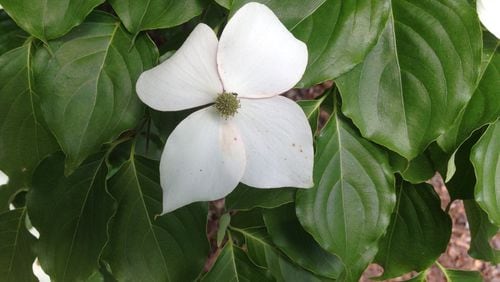Q: Is there a dogwood or any other small/medium flowering tree or shrub that will tolerate full afternoon sun? Steve Preston, Decatur
A: Kousa dogwood or any of its varieties grow great in full sun. It is one of my favorite trees to see blooming in May, covered in white bracts! Kousa dogwood comes from Asia. Unlike our native dogwood, it blooms when the tree has leaves. For sun tolerance, I also love the various panicle hydrangeas. 'Vanilla Strawberry', 'Limelight', 'Little Lime' and 'PeeGee' are examples.
Q: I am trying to eliminate obnoxious volunteer Bradford pear bushes. Is there a way to kill the roots without waiting for regrowth and using weed killer? Barbara Webb, email
A: You could dig the roots out, but I'm guessing that's not what you want to do. Unfortunately, there is nothing that will make the roots die any faster than persistent application of a weed killer to the green leaves. Unlike some weed killers, glyphosate (Roundup, etc.) translocates in the plant it's sprayed on. That means it is transported by the sap a few feet from the application site. But my experience with the thorny, brushy form of Bradford pear is that there are plenty of roots that are many feet long. They will continue to send up green shoots for several months after a tree is cut down. Keep a sharp eye out for the green leaves. When seen, remove them immediately by clipping or using weed killer. The roots will eventually die.
Q: Recently I was told that St. Augustine lawns have a natural life span of less than 15 years. My own experience refutes this. Charles Nevaril, Naples, Fla.
A: I agree with you! My own St. Augustine lawn has been here for 20 years. But in your part of Florida, stressors such as sandy soil, drought, chinch bugs, and take-all root rot could mean that most St. Augustine lawns give up and have to be replaced after approximately 15 years.
Q: Can you give a list of vegetable plants that are not affected by bacterial wilt. I had this disease diagnosed in my tomatoes last year. Joyce Garrett, Avondale
A: There is only a very narrow selection! I have never heard of sweet corn getting bacterial wilt but beans, peas, tomatoes, peppers, eggplants, plus most squash, melons and cucumbers are susceptible to this disease. Once your garden soil is infested, the bacteria spores stick around for a long time. But there are a couple of things you can do to have reasonably healthy vegetables. Be sure the garden is completely weed free in winter, since some weeds can harbor the bacteria in their roots. Add any amendment you can to the soil so it drains rapidly after a rain. Consider making raised hills, or raised rows, with furrows in between, so water goes downward quickly. Become familiar with bacterial wilt symptoms on each of your vegetables, so if you do spot it, you can get the plant out before it infects those nearby. Good luck!






